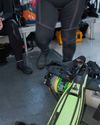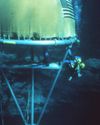Even though DCS might seem subtle, it could be serious.

We were in the Maldives for a seven-day liveaboard. Almost all the dives we did were deep, the currents were running, and often we found ourselves finning into them as we followed the guides, on the lookout for the sharks and rays this remarkable atoll is famous for. The trip was taking place during the rainy season, and we had already surfaced a few times in heavy downpours, with visibility on the surface reduced to a few metres.
SWIMMING FOR SAFETY
On the fifth day, we did two dives, and by about 4pm we were ready to jump in for number three. The water was soupy, green. Bottoming out at around 38 metres, we swam along the outer reef towards the entrance to the channel, which we approached from below the lip that marks the passage into the lagoon.
We ascended slowly up the lip to about 26 metres, feeling the strength of the current increasing as we climbed. But it was going the wrong way, not into the lagoon where the boat would meet us, but out to the open ocean. And it was very strong. Our regulators were rattling in our mouths, and as we cleared the top of the lip, we had to hold onto the rocky substrate to keep ourselves from being pulled off the reef.
The guide called the dive, instructing everyone to start the ascent. We let go and the reef disappeared from view in a matter of seconds. It took us at least eight minutes to reach the surface, all of us making conservative safety stops on the way.
By the time we hit the surface, the current had pulled us a long way from the atoll. The boat, waiting for us in the prearranged spot, was now just a speck on the horizon. It was about 4.45pm, and we had about an hour and half of daylight left. Looking to the west, a squall was fast approaching. We calculated that we had about 20 minutes for the boat to pick us up before the rain hit, closing out the visibility and making it impossible for us to be seen.
Bu hikaye Scuba Diver dergisinin Issue 01-2017 (107) sayısından alınmıştır.
Start your 7-day Magzter GOLD free trial to access thousands of curated premium stories, and 9,000+ magazines and newspapers.
Already a subscriber ? Giriş Yap
Bu hikaye Scuba Diver dergisinin Issue 01-2017 (107) sayısından alınmıştır.
Start your 7-day Magzter GOLD free trial to access thousands of curated premium stories, and 9,000+ magazines and newspapers.
Already a subscriber? Giriş Yap

The Making Of A World Record-Breaking Diver
Descending more than 300 metres into the depths of the ocean may sound like a daunting prospect to even the most seasoned diver. But to one man, it was just another a challenge that he set for himself to see how far he was able to push the envelope.

Risk Mitigation: Hose Failure
An unexpected outcome

Top 10 Wrecks Of Asia-Pacific
We present a curated list of the top 10 most famous wrecks found in the Asia-Pacific region, listed in no particular order

From The Medical Line: Diving After DCS
DAN medical information specaialists and researchers answer your dive medicine questions

Cave Exploration: Beginning With The End In Mind
Building complex adventures on simple skills

Dive Slate: Stay Safe On Board
When preparing for a dive, safety is at the top of the list – checking gear, learning potential site hazards and discussing procedures with your divemaster or buddy.

101 Tips On Becoming A Better Tek Diver
Technical diving takes divers beyond the typical recreational scuba diving limits, opening up many new and exciting possibilities.

TECHNICAL DIVING TIMELINE (1660–1999)
It’s fair to say that the emergence of “technical diving” in the late 1980s, that is, the introduction of mixed gas technology, and later mixed gas rebreathers to the sport diving community, represented the culmination of hundreds of years of scientific discovery and technological development.

FLYING AFTER DIVING
From the Safety Stop

DIAGNOSING DECOMPRESSION ILLNESS
Incident Insight